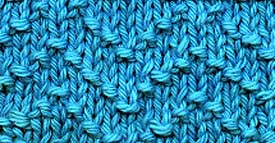

Hundreds Of Free Knitting Patterns And So Much More |
Barbara Breiter's Knitting On The Net |
|
Learn To Knit
|
Learn To KnitKeeping To Patternby Barbara Breiter Literally thousands of stitch patterns exist and they produce unique and beautiful designs. You could knit a hundred baby blankets with the same yarn but use a different stitch pattern and each would look totally different. When you knit something that has no shaping such as a blanket or a scarf, you just merrily continue knitting. Each row of the stitch pattern will begin and end as written. But when you knit a sweater, hat, or other project where you must increase or decrease stitches, you'll run into the term "keeping to pattern". Because you have added or subtracted stitches, each row will no longer begin and end as written. Many times, you can simply look at your knitting and see where you are at within the stitch pattern. This is why it's important to learn to "read your knitting" and understand by looking at your knitting the sequence of knits, purls, cables, etc. Other times it is more difficult to understand where you are in the stitch pattern or perhaps you have just begin knitting and haven't yet gained experience and confidence. If you're not sure how this keeping to pattern business works, let's work through an example.  Multiple of 8 stitches
Row 1 (RS): *p1, k3; rep from * across
Multiple of 8 stitches
Row 1 (RS): *p1, k3; rep from * acrossRow 2: *k1, p5, k1, p1; rep from * across Row 3: *k2, p1, k3, p1, k1; rep from * across Row 4: *p2, k1, p1, k1, p3; rep from * across Let's suppose you began with 16 stitches and you have increased one stitch on each end on Row 4. You now have 18 stitches and you can no longer begin Row 1 with p1. You don't have a multiple of 8 and knits and purls will no longer align as intended. How should you be keeping to pattern when you work Row 1? You would begin with a knit, not a purl, then proceed to begin the row as written. The first stitch you work is the last stitch of the row written out. You are working backwards from the end of the repeat to the beginning of the repeat as you increase more stitches. Now you will have one extra stitch at the end of the row because you increased two stitches total. As written, you ended Row 1 with k3. Because you have an extra stitch, the row will now end with p1, which is the first stitch of the row as written. The last stitch you work is the first stitch of the row written out. The repeat is starting over again. However, you won't have enough stitches to complete the row as written. Remember that where you begin and end will change each time you add more stitches. When you decrease you are eliminating stitches, so you won't have enough stitches to either begin or end the pattern stitch as written. In this example, we'll say you began with 64 stitches and have bound off 4 stitches on each end. You now have 56 stitches which is still a multiple of 8. But because you've eliminated 4 stitches on each end, you'll have to keep to pattern and change where you begin and end each row. Suppose you are knitting Row 3. You've eliminated the first 4 stitches and you would begin with the fifth stitch. The row would start with k2. You don't need to worry about ending the row when you decrease. As long as you begin in the correct place, the row will end when you've run out of stitches and they will all be aligned as intended. Remember, just as with increasing, where you begin and end will change each time you decrease more stitches. The Complete Idiot's Guide To Knitting
|